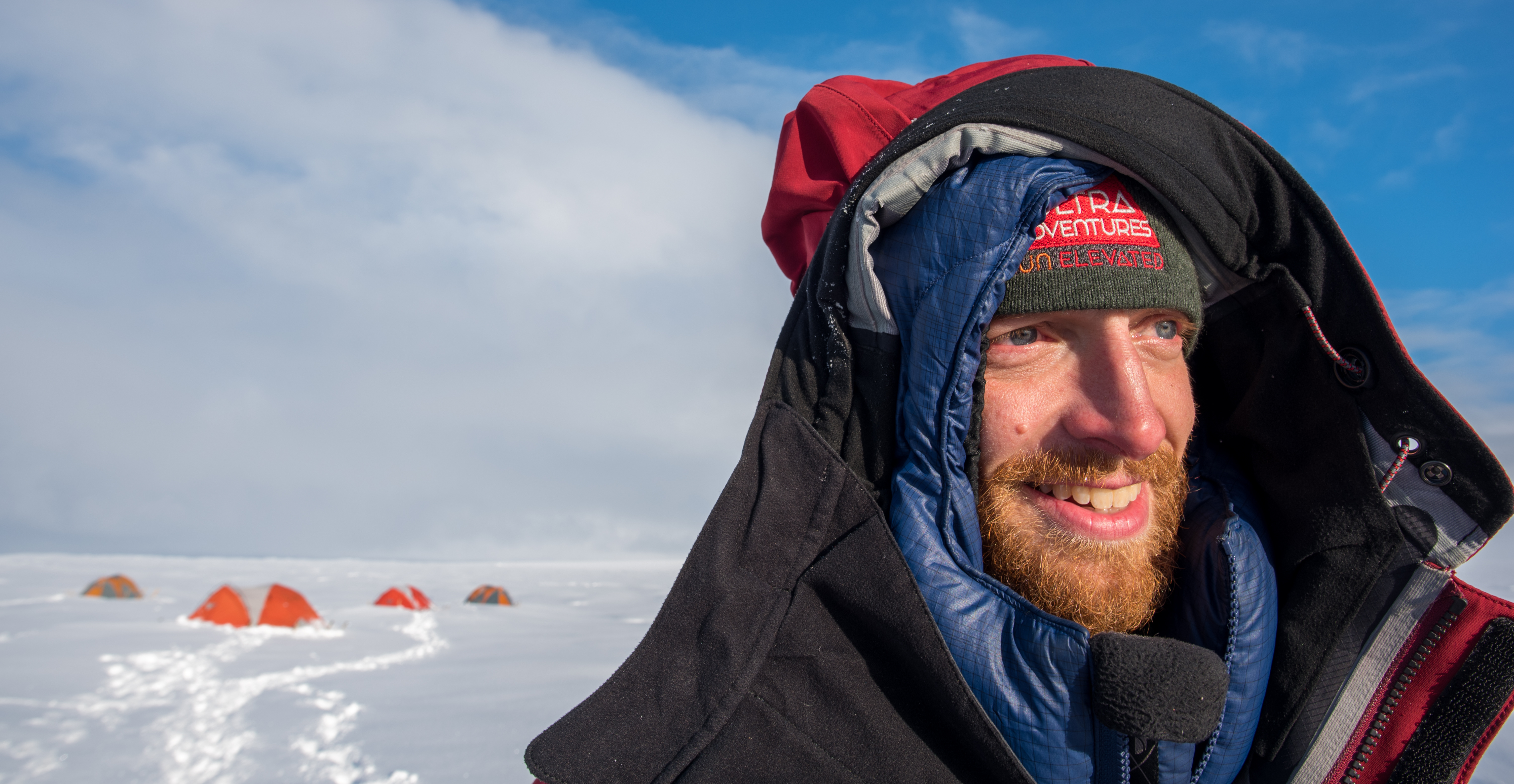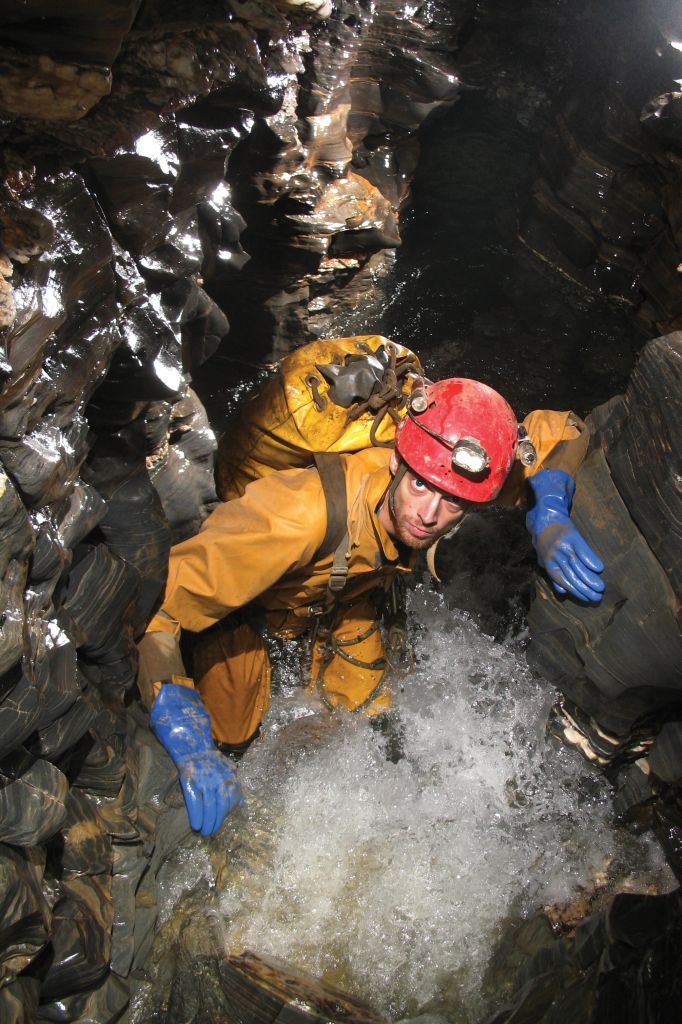Matt Covington On Facing Fears
Geoscientist Dr. Matt Covington has created a prolific caving career through facing his fears and following his passion in the field.
This article is from our limited-run newsletter series, Sincerely Science. Read more from the series, or sign up to receive all 6 editions of this series in your inbox.

Dr. Matt Covington was hanging from a rope 50 feet into a narrow ice cave in Greenland when he heard pops and cracks in the walls around him.
Covington, an avid spelunker and researcher of karst formations, is used to going into caves made out of rock. Ice caves are uniquely dynamic—icicles and walls are forming, breaking, and reforming constantly. His first time mapping a glacial cave made from ice was, as he puts it, “terrifying.”
But if you were to ask Covington, he might say that there’s nowhere else he’d rather be.
Covington wasn’t always set out to become a geologist hanging in an ice hole. He actually started his science career in astrophysics, studying the evolution of galaxies and what happens when they merge. But after school, exploring caves—in Mexico, Slovenia, and around the world—filled his life. “I enjoy doing a lot of things outside—mountain biking, rock climbing, whitewater kayaking—but caving is number one,” Covington says.
Even though the science of exoplanets seems starkly different from land behavior on Earth, Covington started to see similarities between the two studies pop up everywhere. During a seminar about using a statistical technique to model galaxy formation, Covington was struck by a question. “I started thinking, ‘I wonder if you could use a similar technique to study the evolution of caves.’ Then that was all I could think about, for the rest of the seminar.”
Much like squeezing oneself through a narrow hole in rock, taking the plunge from physics to geology felt nerve-wracking. “I was basically in denial with myself,” he recalls. “On a popular science level, [physics is] just a really sexy topic. I thought, ‘I should be more interested in this.’ In reality, when I was finally honest with myself, I’m just more interested in caves.”
Now, Covington’s research subjects cover many things, but the touchpoint is caves—how they form, their effect on water quality, how they impact the motion of glaciers, and more. He often uses the principles of physics and physics research to investigate.

It’s hard to know where your passions really lie. But for Covington, his passions also happen to coincide with some of his greatest fears.
“I’m actually quite afraid of heights,” he admits.
“As a kid, my parents couldn’t get me to go within 20 feet of the edge of a cliff, I was terrified of heights. But I’ve learned to manage it. It doesn’t keep me from doing things I want to do,” says Covington.
Facing his fears, whether it be in the form of traversing a dark, steep cave, or in the form of approaching loved ones about a career shift, has taught Covington tricks to keep himself on track in a difficult situation. He says it helps him stay focused on the science of his job, and keeps his worries at bay.
“The thing that’s most important for me is to focus. Focusing on the motions of: ‘I’m at this anchor, I need to cross it. This is step one, this is step two.’ Just the world right around me, the things that I need to do, and moving through them is the thing that helps me the most. One step at a time.” —Matt Covington
The moments that Covington dreaded the most were telling his parents and his dissertation advisor about his transition to geology. “I expected to get this lecture of, ‘You’re throwing away all this education you spent in physics. It’s crazy!’ But after I explained what I was planning on doing, my mom [said], ‘I always thought you should have been a geologist,’” he says.
What gives Covington the most gratitude about his work is the fact that he was able to wrangle his love of geographic exploration into real scientific contributions to speleology. He says that an outsized percentage of the caving hobbyist community are also scientists. “[It’s] the exploration aspect,” he says.
“The cave environment is bizarre and interesting. I enjoy that a lot, but I think the biggest thing is [that] for someone who’s really curious, it’s the ideal environment. You don’t know what’s around the next corner,” Covington says.
That curiosity has led him to many of his research ideas, including another interplanetary comparison.
Karst landscapes typically have enclosed depressions on their surface, which visually resemble small craters. Right now, scientists don’t know what exactly controls the size of these depressions, and Covington has been thinking about a new approach. “[Saturn’s] moon Titan has landscapes on it that look like karst. But one of the puzzling things is that the depressions are huge—they’re tens to a hundred kilometers across—compared to anything we see on Earth.”
What is it about Titan’s terrain that makes karst-like landscapes have such huge depressions? And can that teach us something about karst on Earth? “It’s something I’m excited about right now,” says Covington.
An explorer mindset can be motivating for any scientist. Even when Covington is buried in paperwork, emails, and all the other more boring realities of being a professional, it helps ground him in why he does his work in the first place.
“One of the things I’ve tried to do is to focus more on the science that makes me most excited and that I’m most interested in, rather than the science that is going to bring in the most funding or is going to create that Nature paper. And you know, I think that’s where I do the best [quality] science,” says Covington.
Sometimes, the ideas that excite you the most can also be the scariest to accept. Or in Covington’s case, to actually do. But the rewards of doing what motivates him to wake up on the side of a freezing cliff in Greenland are worth it.
Emma Lee Gometz is Science Friday’s Digital Producer of Engagement. She writes SciFri’s “Science Goes To The Movies” series and is a journalist and illustrator based in Queens, NY.